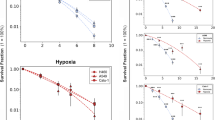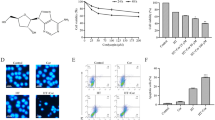Abstract
Sanazole has been tested clinically as a hypoxic cell radiosensitizer. In this study, we determined whether sanazole enhances the radiation-induced apoptosis of human lymphoma U937 cells. Our results revealed that, compared with 10 mM sanazole or radiation alone, the combination of both resulted in a significant enhancement of apoptosis after 6 h, which was evaluated on the basis of DNA fragmentation, morphological changes, and phosphatidylserine externalization. Sanazole alone enhanced intracellular superoxide and hydrogen peroxide formation, which further increased when the cells were irradiated. Significant enhancement of Fas externalization, loss of mitochondrial membrane potential (MMP), and activation of caspase-3 and caspase-8 were observed after the combined treatment. Moreover, this combination could also enhance Bid activation, reduction of Hsp70 expression level and release of cytochrome c from the mitochondria to the cytosol. An immediate increase in the intracellular Ca2+ concentration ([Ca2+]i) was observed after the combined treatment. These results suggest that the intracellular superoxide and peroxide generated by sanazole might be involved in the enhancement of radiation-induced apoptosis, and that these effects are associated with modulation of the Fas-mitochondria-caspase-dependent pathway, an increase in [Ca2+]i, and a decrease in the Hsp70 expression levels.







Similar content being viewed by others
References
Szostak MJ, Kyprianou N (2000) Radiation-induced apoptosis: predictive and therapeutic significance in radiotherapy of prostate cancer. Oncol Rep 7:699–706
Garzotto M, Haimovitz-Friedman A, Liao WC et al (1999) Reversal of radiation resistance in LNCaP cells by targeting apoptosis through ceramide synthase. Cancer Res 59:5194–5201
Lin X, Zhang F, Bradbury CM et al (2003) 2-Deoxy-d-glucose-induced cytotoxicity and radiosensitization in tumor cells is mediated via disruptions in thiol metabolism. Cancer Res 63:3413–3417
Belka C, Jendrossek V, Pruschy M, Vink S, Verheij M, Budach W (2004) Apoptosis-modulating agents in combination with radiotherapy-current status and outlook. Int J Radiat Oncol Biol Phys 58:542–554. doi:10.1016/j.ijrobp.2003.09.067
Sugie C, Shibamoto Y, Ito M et al (2005) Reevaluation of the radiosensitizing effects of sanazole and nimorazole in vitro and in vivo. J Radiat Res 46:453–459. doi:10.1269/jrr.46.453
Shibamoto Y, Sakano K, Kimura R et al (1986) Radiosensitization in vitro and in vivo by 3-nitrotriazoles. Int J Radiat Oncol Biol Phys 12:1063–1066
Dobrowsky W, Huigol NG, Jayatilake RS et al (2007) AK-2123 (Sanazol) as a radiation sensitizer in the treatment of stage III cervical cancer: results of an IAEA multicentre randomised trial. Radiother Oncol 82:24–29. doi:10.1016/j.radonc.2006.11.007
Huilgol NG, Chatterjee N, Mehta AR (1996) An overview of the initial experience with AK-2123 as a hypoxic cell sensitizer with radiation in the treatment of advanced head and neck cancers. Int J Radiat Oncol Biol Phys 34:1121–1124. doi:10.1016/0360-3016(95)02181-7
Ullal SD, Shenoy KK, Pai MR et al (2006) Safety and radiosensitizing efficacy of sanazole (AK 2123) in oropharyngeal cancers: randomized controlled double blind clinical trial. Indian J Cancer 43:151–155
Wardman P (2007) Chemical radiosensitizers for use in radiotherapy. Clin Oncol 19:397–417. doi:10.1016/j.clon.2007.03.010
Pasupathy K, Nair CK, Kagiya TV (2001) Effect of a hypoxic radiosensitizer, AK 2123 (Sanazole), on yeast Saccharomyces cerevisiae. J Radiat Res (Tokyo) 42:217–227. doi:10.1269/jrr.42.217
Aoki M, Furusawa Y, Shibamoto Y, Kobayashi A, Tsujitani M (2002) Effect of a hypoxic cell sensitizer doranidazole on the radiation-induced apoptosis of mouse L5178Y lymphoma cells. J Radiat Res 43:161–166. doi:10.1269/jrr.43.161
Rajagopalan R, Kagiya TV, Nair CK (2003) Radiosensitizer sanazole (AK-2123) enhances gamma-radiation-induced apoptosis in murine fibrosarcoma. J Radiat Res 44:359–365. doi:10.1269/jrr.44.359
Sellins KS, Cohen JJ (1987) Gene induction by gamma-irradiation leads to DNA fragmentation in lymphocytes. J Immunol 139:3199–3206
Zhao QL, Fujiwara Y, Kondo T (2006) Mechanism of cell death induction by nitroxide and hyperthermia. Free Radic Biol Med 40:1131–1143. doi:10.1016/j.freeradbiomed.2005.10.064
van Heerde WL, de Groot PG, Reutelingsperger CP (1995) The complexity of the phospholipid binding protein Annexin V. Thromb Haemost 73:172–179
Gorman A, McGowan A, Cotter TG (1997) Role of peroxide and superoxide anion during tumour cell apoptosis. FEBS Lett 404:27–33. doi:10.1016/S0014-5793(97)00069-0
Royall JA, Ischiropoulos H (1993) Evaluation of 2′,7′-dichlorofluorescin and dihydrorhodamine 123 as fluorescent probes for intracellular H2O2 in cultured endothelial cells. Arch Biochem Biophys 302:348–355. doi:10.1006/abbi.1993.1222
Datta R, Kojima H, Yoshida K, Kufe D (1997) Caspase-3-mediated cleavage of protein kinase C θ in induction of apoptosis. J Biol Chem 272:20317–20320. doi:10.1074/jbc.272.33.20317
Cui ZG, Kondo T, Matsumoto H (2006) Enhancement of apoptosis by nitric oxide released from alpha-phenyl-tert-butyl nitrone under hyperthermic conditions. J Cell Physiol 206:468–476. doi:10.1002/jcp.20482
Tsujimoto Y, Shimizu S (2000) Bcl-2 family: life-or-death switch. FEBS Lett 466:6–10. doi:10.1016/S0014-5793(99)01761-5
Beere HM, Wolf BB, Cain K et al (2000) Heat-shock protein 70 inhibits apoptosis by preventing recruitment of procaspase-9 to the Apaf-1 apoptosome. Nat Cell Biol 2:469–475. doi:10.1038/35019501
Saleh A, Srinivasula SM, Balkir L, Robbins PD, Alnemri ES (2000) Negative regulation of the Apaf-1 apoptosome by Hsp70. Nat Cell Biol 2:476–483. doi:10.1038/35019510
Salganik RI (2001) The benefits and hazards of antioxidants: controlling apoptosis and other protective mechanisms in cancer patients and the human population. J Am Coll Nutr 20:464S–472S (discussion 473S–475S)
Singh SV, Srivastava SK, Choi S et al (2005) Sulforaphane-induced cell death in human prostate cancer cells is initiated by reactive oxygen species. J Biol Chem 280:19911–19924. doi:10.1074/jbc.M412443200
Riley PA (1994) Free radicals in biology: oxidative stress and the effects of ionizing radiation. Int J Radiat Biol 65:27–33. doi:10.1080/09553009414550041
Wallace SS (1998) Enzymatic processing of radiation-induced free radical damage in DNA. Radiat Res 150:S60–S79. doi:10.2307/3579809
Cui ZG, Kondo T, Ogawa R et al (2004) Enhancement of radiation-induced apoptosis by 6-formylpterin. Free Radic Res 38:363–373. doi:10.1080/1071576042000191754
Schepetkin IA, Cherdyntseva NV, Kagiya VT (2001) Sanazole as substrate of xanthine oxidase and microsomal NADPH/cytochrome P450 reductase. Pathophysiology 8:119–127. doi:10.1016/S0928-4680(01)00073-6
Chen M, Wang J (2002) Initiator caspases in apoptosis signaling pathways. Apoptosis 7:313–319. doi:10.1023/A:1016167228059
Nagata S (1997) Apoptosis by death factor. Cell 88:355–365. doi:10.1016/S0092-8674(00)81874-7
Wang X (2001) The expanding role of mitochondria in apoptosis. Genes Dev 15:2922–2933
Li H, Zhu H, Xu CJ, Yuan J (1998) Cleavage of BID by caspase 8 mediates the mitochondrial damage in the Fas pathway of apoptosis. Cell 94:491–501. doi:10.1016/S0092-8674(00)81590-1
He L, Fox MH (1997) Variation of heat shock protein 70 through the cell cycle in HL-60 cells and its relationship to apoptosis. Exp Cell Res 232:64–71. doi:10.1006/excr.1997.3494
Brondani Da Rocha A, Regner A, Grivicich I et al (2004) Radioresistance is associated to increased Hsp70 content in human glioblastoma cell lines. Int J Oncol 25:777–785
Nitobe J, Yamaguchi S, Okuyama M et al (2003) Reactive oxygen species regulate FLICE inhibitory protein (FLIP) and susceptibility to Fas-mediated apoptosis in cardiac myocytes. Cardiovasc Res 57:119–128. doi:10.1016/S0008-6363(02)00646-6
Strasser A, Newton K (1999) FADD/MORT1, a signal transducer that can promote cell death or cell growth. Int J Biochem Cell Biol 31:533–537. doi:10.1016/S1357-2725(99)00003-5
Yin XM (2000) Signal transduction mediated by Bid, a pro-death Bcl-2 family proteins, connects the death receptor and mitochondria apoptosis pathways. Cell Res 10:161–167. doi:10.1038/sj.cr.7290045
Asada S, Fukuda K, Nishisaka F, Matsukawa M, Hamanisi C (2001) Hydrogen peroxide induces apoptosis of chondrocytes; involvement of calcium ion and extracellular signal-regulated protein kinase. Inflamm Res 50:19–23. doi:10.1007/s000110050719
Macho A, Hirsch T, Marzo I et al (1997) Glutathione depletion is an early and calcium elevation is a late event of thymocyte apoptosis. J Immunol 158:4612–4619
Costantini P, Chernyak BV, Petronilli V, Bernardi P (1996) Modulation of the mitochondrial permeability transition pore by pyridine nucleotides and dithiol oxidation at two separate sites. J Biol Chem 271:6746–6751. doi:10.1074/jbc.271.12.6746
Nicotera P, Bellomo G, Orrenius S (1992) Calcium-mediated mechanisms in chemically induced cell death. Annu Rev Pharmacol Toxicol 32:449–470. doi:10.1146/annurev.pa.32.040192.002313
Author information
Authors and Affiliations
Corresponding author
Rights and permissions
About this article
Cite this article
Yu, DY., Zhao, QL., Wei, ZL. et al. Enhancement of radiation-induced apoptosis of human lymphoma U937 cells by sanazole. Apoptosis 14, 655–664 (2009). https://doi.org/10.1007/s10495-009-0329-7
Published:
Issue Date:
DOI: https://doi.org/10.1007/s10495-009-0329-7




